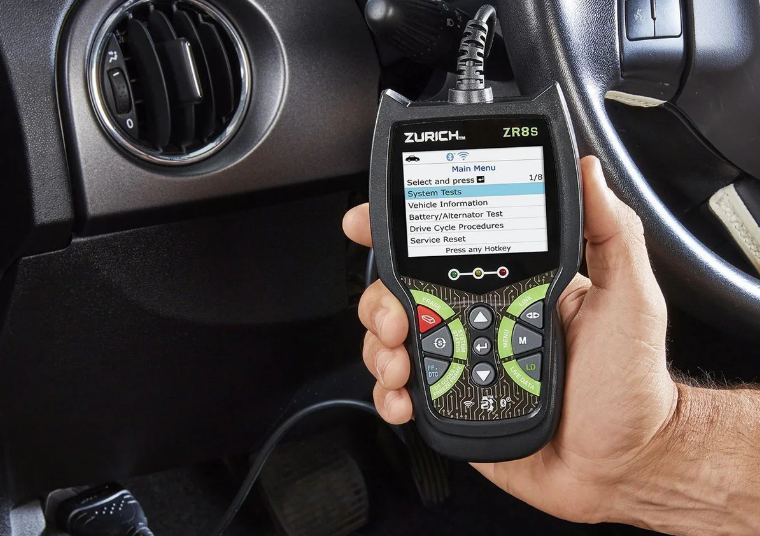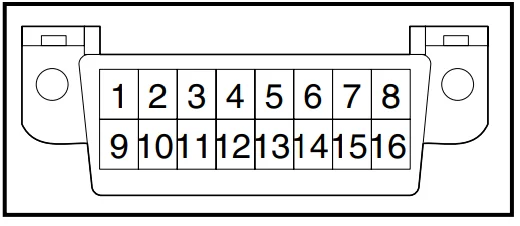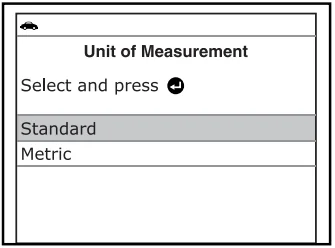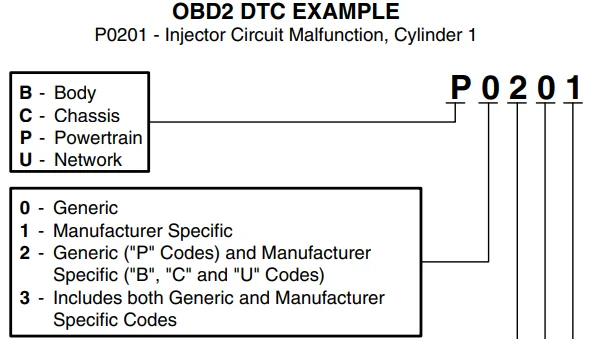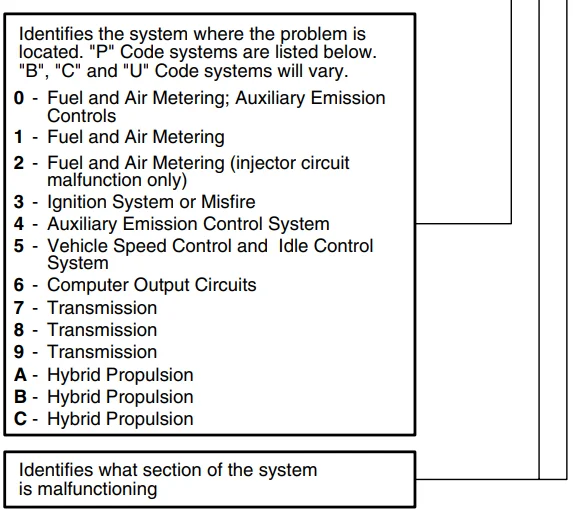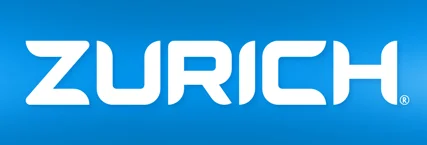
Zurich 63809 ZR8 OBD2 Code Reader
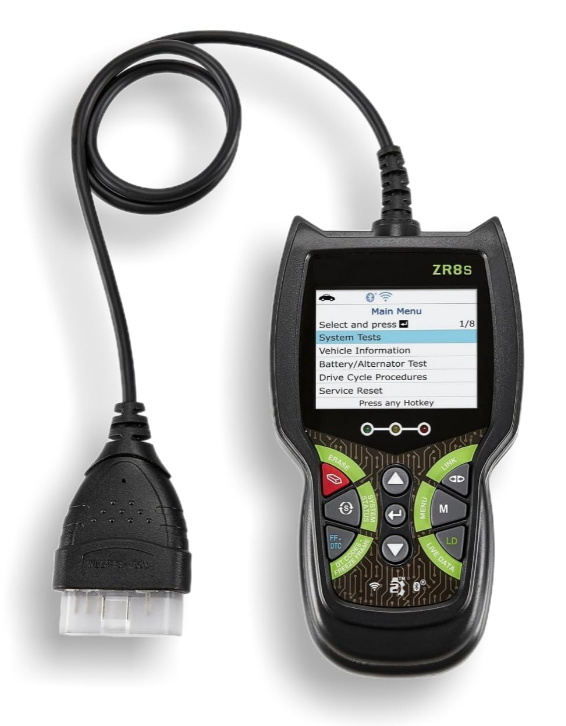
About the Code Reader
VEHICLES COVERED
The Code Reader is designed to work on all OBD2-compliant vehicles. All 1996 and newer vehicles (cars and light trucks) sold in the United States are OBD2 compliant. This includes all Domestic, Asian, and European vehicles. Coverage for new model vehicles may be limited and will be available once released by the automaker. Availability is typically 12 to 24 months after the release of the model year.
Note: Some 1994 and 1995 vehicles are OBD2 compliant. To find out if a 1994 or 1995 vehicle is OBD2 compliant, check the following:
- The Vehicle Emissions Control Information (VECI) Label. This label is located under the hood or by the radiator of most vehicles. If the vehicle is OBD2 compliant, the label will state “OBD II Certified.”

- Government regulations require that all OBD2-compliant vehicles must have a “common” sixteen-pin Data Link Connector (DLC). Some 1994 and 1995 vehicles have 16-pin connectors but are not OBD2 compliant. Only those vehicles with a Vehicle Emissions Control Label stating “OBD II Certified” are OBD2 compliant.

Data Link Connector (DLC) Location
The 16-pin DLC is usually located under the instrument panel (dash), within 12 inches (300 mm) of the center of the panel, on the driver’s side of most vehicles. It should be easily accessible and visible from a kneeling position outside the vehicle with the door open.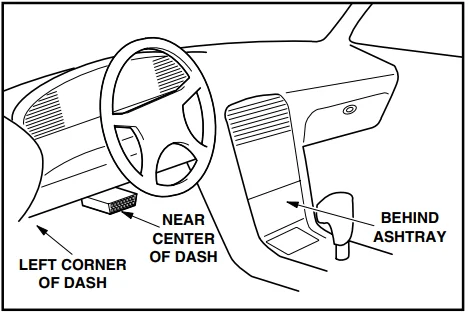
Note: On some Asian and European vehicles, the DLC is located behind the ashtray (the ashtray must be removed to access it) or on the far-left corner of the dashboard. If the DLC cannot be located, consult the vehicle’s service manual for the location.
CONTROLS AND INDICATORS
See Figure 1 for the locations of items 1 through 14 below.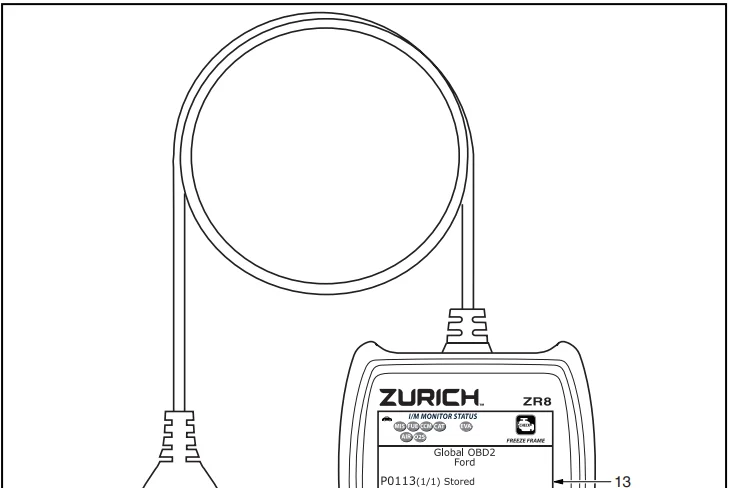
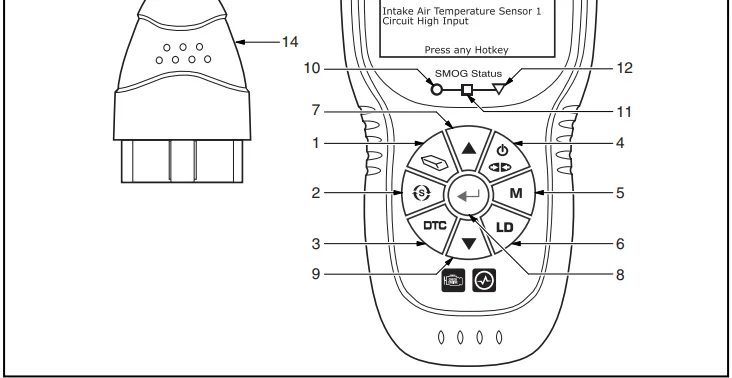
 ERASE button – Erases Diagnostic Trouble Codes (DTCs) and “Freeze Frame” data from your vehicle’s computer, and resets monitor status.
ERASE button – Erases Diagnostic Trouble Codes (DTCs) and “Freeze Frame” data from your vehicle’s computer, and resets monitor status. SYSTEM MENU button – When pressed, displays the System Menu.
SYSTEM MENU button – When pressed, displays the System Menu.- DTC/FF button – Displays the DTC View screen and/or scrolls the LCD to view DTCs and Freeze Frame data.
 LINK button – When the Code Reader is connected to a vehicle, it links the Code Reader to the vehicle’s PCM to retrieve diagnostic data from the computer’s memory.
LINK button – When the Code Reader is connected to a vehicle, it links the Code Reader to the vehicle’s PCM to retrieve diagnostic data from the computer’s memory.- M (Menu) button – When pressed while linked to a vehicle, displays the Main Menu.
- LD button – When pressed while linked to a vehicle, places the Code Reader in Live Data mode.
- ▲ UP button – When in MENU mode, scrolls up through the menu and submenu selection options. When linked to a vehicle, scrolls up through the current display screen to display any additional data.
- ⬅ENTER button – When in Menu mode, confirms the selected option or value.
- ▼DOWN button – When in MENU mode, scrolls down through the menu and submenu selection options. When linked to a vehicle, scrolls down through the current display screen to display any additional data.
- GREEN LED – Indicates that all engine systems are running normally (all monitors on the vehicle are active and performing their diagnostic testing, and no DTCs are present).
- YELLOW LED – Indicates there is a possible problem. A “Pending” DTC is present, and/or some of the vehicle’s emission monitors have not run their diagnostic testing.
- RED LED – Indicates there is a problem in one or more of the vehicle’s systems. The red LED is also used to show that DTC(s) are present. DTCs are shown on the Code Reader’s LCD. In this case, the Multifunction Indicator (“Check Engine”) lamp on the vehicle’s instrument panel will light steadily on.
- LCD Display – Displays test results, Code Reader functions, and monitor status information. See Display Functions below for details.
- CABLE – Connects the Code Reader to the vehicle’s Data Link Connector (DLC).
DISPLAY FUNCTIONS
See Figure 2 for the locations of items 1 through 14 below.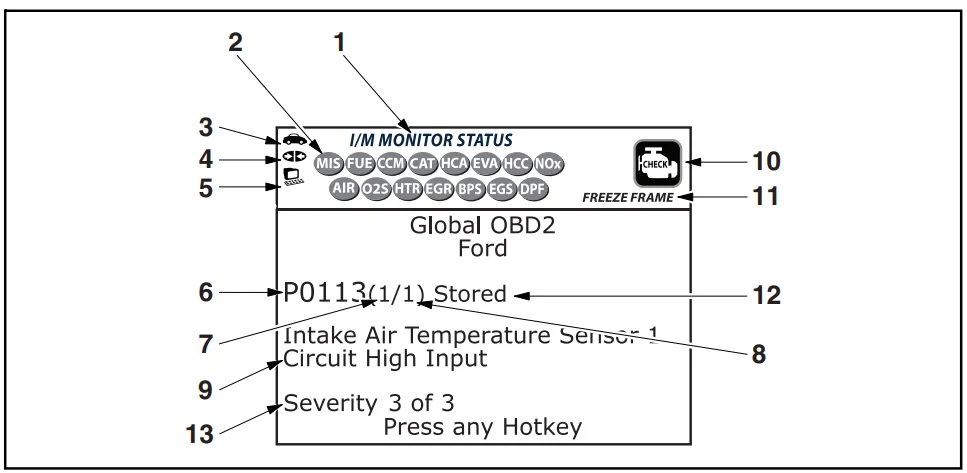
- I/M MONITOR STATUS field – Identifies the I/M Monitor status area.
- Monitor icons – Indicate which monitors are supported by the vehicle under test, and whether or not the associated monitor has run its diagnostic testing (Monitor status). When a monitor icon is solid green, it indicates that the associated monitor has completed its diagnostic testing. When a monitor icon is flashing red, it indicates that the vehicle supports the associated monitor, but the monitor has not yet run its diagnostic testing.
 Vehicle icon – Indicates whether or not the Code Reader is being properly powered through the vehicle’s Data Link Connector (DLC). A visible icon indicates that the Code Reader is being powered through the vehicle’s DLC connector.
Vehicle icon – Indicates whether or not the Code Reader is being properly powered through the vehicle’s Data Link Connector (DLC). A visible icon indicates that the Code Reader is being powered through the vehicle’s DLC connector. Link icon – Indicates whether or not the Code Reader is communicating (linked) with the vehicle’s onboard computer. When visible, the Code Reader is communicating with the computer. If the Link icon is not visible, the Code Reader is not communicating with the computer.
Link icon – Indicates whether or not the Code Reader is communicating (linked) with the vehicle’s onboard computer. When visible, the Code Reader is communicating with the computer. If the Link icon is not visible, the Code Reader is not communicating with the computer. Computer icon – When this icon is visible, it indicates that the Code Reader is linked to a personal computer.
Computer icon – When this icon is visible, it indicates that the Code Reader is linked to a personal computer.- DTC Display Area – Displays the Diagnostic Trouble Code (DTC) number.
- Code Number Sequence – The Code Reader assigns a sequence number to each DTC that is present in the computer’s memory, starting with “1.” This number indicates which code is currently displayed. Code number “1” is always the highest priority code and the one for which “Freeze Frame” data has been stored. If “1” is a “Pending” code, there may or may not be “Freeze Frame” data stored in memory.
- Code Enumerator – Indicates the total number of codes retrieved from the vehicle’s computer.
- Test Data Display Area – Displays DTC definitions, Freeze Frame data, and other pertinent test information messages.
- SYSTEM icon – Indicates the system with which the code is associated (MIL icon, ABS icon).

- FREEZE FRAME icon – Indicates that there is Freeze Frame data from “Priority Code” (Code #1) stored in the vehicle’s computer memory.
- Code type – Indicates the type of code being displayed: Generic Stored, Generic Pending, Generic Permanent, etc.
- Severity – Indicates the level of severity for the priority code (code number “1”) as follows:
DISPLAY FUNCTIONS – INITIAL ADJUSTMENTS
- Service should be scheduled and repairs made when convenient. This DTC typically has no immediate threat to essential system components in the short term.
- Repair immediately if drivability issues are present. Threat to essential system components if not repaired as soon as possible.
- Stop and repair the vehicle immediately to prevent interrelated failures. Harmful and damaging to essential system components.
INITIAL ADJUSTMENTS
The first time the unit is connected to a vehicle, the Select Language screen displays. You must select the desired display language (English, French, or Spanish) and unit of measurement (USA or Metric) as follows:
- Use the UP ▲ and DOWN ▼buttons, as necessary, to highlight the desired display language.
- When the desired display language is selected, press the ENTER ⬅button to confirm your selection. The Select Unit screen displays.

- Use the UP ▲ and DOWN ▼ buttons, as necessary, to highlight the desired unit of measurement.

- When the desired unit of measurement is selected, press the ENTER ⬅button to confirm your selection.
Note: After the initial language and unit of measurement selections are performed, these, as well as other settings, can be changed as desired. Proceed to Adjustments, Settings, and Language on page 57 for further instructions.
OBD2 TERMINOLOGY
The following terms and their definitions are related to OBD2 systems. Read and reference this list as needed to aid in the understanding of OBD2 systems.
- Powertrain Control Module (PCM) – The PCM is the OBD2 accepted term for the vehicle’s onboard computer. In addition to controlling the engine management and emissions systems, the PCM also participates in controlling the powertrain (transmission) operation. Most PCMs also have the ability to communicate with other computers in the vehicle (ABS, ride control, body, etc.).
- Monitor – Monitors are diagnostic routines programmed into the PCM. The PCM utilizes these programs to run diagnostic tests and to monitor the operation of the vehicle’s emissions-related components or systems to ensure they are operating correctly and within the vehicle manufacturer’s specifications. Currently, up to fifteen monitors are used in OBD2 systems. Additional monitors will be added as the OBD2 system is further developed. Not all vehicles support all fifteen monitors.
- Enabling Criteria – Each monitor is designed to test and monitor the operation of a specific part of the vehicle’s emissions system (EGR system, oxygen sensor, catalytic converter, etc.). A specific set of conditions or driving procedures must be met before the computer can command a monitor to run tests on its related system. These conditions are known as Enabling Criteria. The requirements and procedures vary for each monitor. Some monitors only require the ignition key to be turned “On” for them to run and complete their diagnostic testing. Others may require a set of complex procedures, such as starting the vehicle when cold, bringing it to operating temperature, and driving the vehicle under specific conditions before the monitor can run and complete its diagnostic testing.
- Monitor Has/Has Not Run – The terms “Monitor has run” or “Monitor has not run” are used throughout this manual. “Monitor has run” means the PCM has commanded a particular monitor to perform the required diagnostic testing on a system to ensure the system is operating correctly (within factory specifications). “Monitor has not run” means the PCM has not yet commanded a particular monitor to perform diagnostic testing on its associated part of the emissions system.
- Trip – A trip for a particular monitor requires that the vehicle be driven in such a way that all the required Enabling Criteria for the monitor to run and complete its diagnostic testing are met. The Trip Drive Cycle for a particular monitor begins when the ignition key is turned “On.” It is completed when all the Enabling Criteria for the monitor to run and complete its diagnostic testing are met by the time the ignition key is turned “Off.” Since each of the fifteen monitors is designed to run diagnostics and testing on a different part of the engine or emissions system, the Trip Drive Cycle needed for each monitor to run and complete varies.
- OBD2 Drive Cycle – An OBD2 Drive Cycle is an extended set of driving procedures that takes into consideration the various types of driving conditions encountered in real life. These conditions may include starting the vehicle when it is cold, driving the vehicle at a steady speed (cruising), accelerating, etc. An OBD2 Drive Cycle begins when the ignition key is turned “On” (when cold) and ends when the vehicle has been driven in such a way as to have all the Enabling Criteria met for all its applicable monitors. Only those trips that provide the Enabling Criteria for all monitors applicable to the vehicle to run and complete their individual diagnostic tests qualify as an OBD2 Drive Cycle. OBD2 Drive Cycle requirements vary from one model of vehicle to another. Vehicle manufacturers set these procedures. Consult your vehicle’s service manual for OBD2 Drive Cycle procedures. Note: Do not confuse a Trip Drive Cycle with an OBD2 Drive Cycle. A Trip Drive Cycle provides the Enabling Criteria for one specific monitor to run and complete its diagnostic testing. An OBD2 Drive Cycle must meet the Enabling Criteria for all monitors on a particular vehicle to run and complete their diagnostic testing.
- Warm-up Cycle – Vehicle operation after an engine off period where engine temperature rises at least 40°F (22°C) from its temperature before starting, and reaches at least 160°F (70°C). The PCM uses warm-up cycles as a counter to automatically erase a specific code and related data from its memory. When no faults related to the original problem are detected within a specified number of warm-up cycles, the code is erased automatically.
DIAGNOSTIC TROUBLE CODES (DTCs)
Diagnostic Trouble Codes (DTCs) are meant to guide you to the proper service procedure in the vehicle’s service manual. Do not replace parts based only on DTCs without first consulting the vehicle’s service manual for proper testing procedures for that particular system, circuit, or component. DTCs are alphanumeric codes that are used to identify a problem that is present in any of the systems monitored by the onboard computer (PCM). Each trouble code has an assigned message that identifies the circuit, component, or system area where the problem was found. OBD2 diagnostic trouble codes are made up of five characters: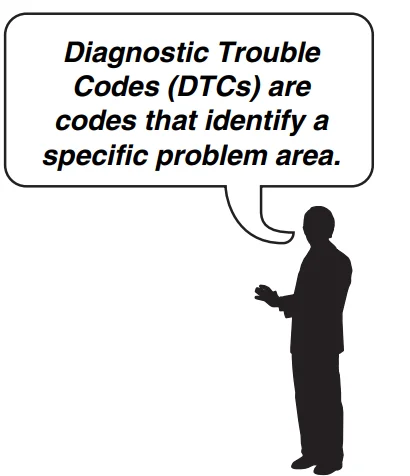
- The 1st character is a letter (B, C, P, or U). It identifies the main system where the fault occurred (Body, Chassis, Powertrain, or Network).
- The 2nd character is a numeric digit (0 through 3). It identifies the type of code (Generic or Manufacturer-Specific). Generic DTCs are codes that are used by all vehicle manufacturers. The standards for generic DTCs, as well as their definitions, are set by the Society of Automotive Engineers (SAE). Note: Manufacturer-Specific DTCs are codes that are controlled by the vehicle manufacturers. The Federal Government does not require vehicle manufacturers to go beyond the standardized generic DTCs in order to comply with the new OBD2 emissions standards. However, manufacturers are free to expand beyond the standardized codes to make their systems easier to diagnose.
- The 3rd character is a letter or numeric digit (0 through 9, A through F). It identifies the specific system or subsystem where the problem is located.
- The 4th and 5th characters are letters or numeric digits (0 through 9, A through F). They identify the section of the system that is malfunctioning.


DTCs and MIL Status
When the vehicle’s onboard computer detects a failure in an emissions-related component or system, the computer’s internal diagnostic program assigns a Diagnostic Trouble Code (DTC) that points to the system (and subsystem) where the fault was found. The diagnostic program saves the code in the computer’s memory. It records a Freeze Frame of the conditions present when the fault was found and lights the Malfunction Indicator Lamp (MIL). Some faults require detection for two trips in a row before the MIL is turned on.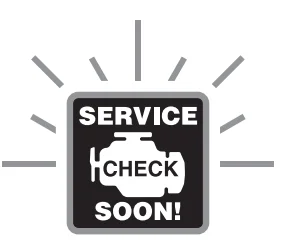
Note: The Malfunction Indicator Lamp (MIL) is the accepted term used to describe the lamp on the dashboard that lights to warn the driver that an emissions-related fault has been found. Some manufacturers may still call this lamp a “Check Engine” or “Service Engine Soon” light.
There are two types of DTCs used for emissions-related faults: Type “A” and Type “B.” Type “A” codes are One-Trip codes; Type “B” DTCs are usually Two-Trip DTCs. When a Type “A” DTC is found on the first trip, the following events take place:
- The computer commands the MIL “On” when the failure is first found.
- If the failure causes a severe misfire that may cause damage to the catalytic converter, the MIL “flashes” once per second. The MIL continues to flash as long as the condition exists. If the condition that caused the MIL to flash is no longer present, the MIL will light steady “On.”
- A DTC is saved in the computer’s memory for later retrieval.
- A Freeze Frame of the conditions present in the engine or emissions system when the MIL was ordered “On” is saved in the computer’s memory for later retrieval. This information shows fuel system status (closed loop or open loop), engine load, coolant temperature, fuel trim value, MAP vacuum, engine RPM, and DTC priority.
When a Type “B” DTC is found on the first trip, the following events take place:
- The computer sets a Pending DTC, but the MIL is not ordered “On.” Freeze Frame data may or may not be saved at this time, depending on the manufacturer. The Pending DTC is saved in the computer’s memory for later retrieval.
- If the failure is found on the second consecutive trip, the MIL is ordered “On.” Freeze Frame data is saved in the computer’s memory.
- If the failure is not found on the second trip, the Pending DTC is erased from the computer’s memory. The MIL will stay lit for both Type “A” and Type “B” codes until one of the following conditions occurs:
- If the conditions that caused the MIL to light are no longer present for the next three trips in a row, the computer automatically turns the MIL “Off” if no other emissions-related faults are present. However, the DTCs remain in the computer’s memory as a history code for 40 warm-up cycles (80 warm-up cycles for fuel and misfire faults). The DTCs are automatically erased if the fault that caused them to be set is not detected again during that period.
- Misfire and fuel system faults require three trips with similar conditions before the MIL is turned off.” These are trips where the engine load, RPM, and temperature are similar to the conditions present when the fault was first found. Note: After the MIL has been turned off, DTCs and Freeze Frame data stay in the computer’s memory.
- Erasing the DTCs from the computer’s memory can also turn off the MIL. See Erasing Diagnostic Trouble Codes (DTCs) on page 33 before erasing codes from the computer’s memory. If a Diagnostic Tool or Code Reader is used to erase the codes, Freeze Frame data will also be erased.
For More Manuals By Zurich, Visit ManualsLibraryy.
Zurich 63809 ZR8 OBD2 Code Reader-FAQs
What is the function of the Zurich ZR8?
The Zurich ZR8 reads and clears check engine light codes, ABS trouble codes, and engine oil light alerts on most Domestic, Asian, and European vehicles. It also displays freeze frame data to show engine conditions at the time a fault occurred.
What types of vehicles are compatible with the Zurich ZR8?
It works with OBD2-compliant vehicles made after 1996, including most cars, SUVs, and light trucks from Domestic, Asian, and European manufacturers.
How do I use the Zurich ZR8 to read and clear codes?
Plug the code reader into your vehicle’s OBD2 port, turn the ignition to “ON,” and select Read Codes on the menu. After viewing fault codes, choose Clear Codes to reset the check engine light once repairs are done.
Does the Zurich ZR8 require batteries to operate?
No, the ZR8 is powered directly by your vehicle’s battery through the OBD2 port — no separate batteries or charging needed.
Can the Zurich ZR8 diagnose ABS problems?
Yes, it can read and clear ABS (Anti-lock Brake System) trouble codes, helping identify brake-related issues in supported vehicles.
What is a hot key on the Zurich code reader?
A hot key is a shortcut button on the device that lets you quickly access key features like code reading, clearing, or live data without navigating through full menus.
Can the Zurich ZR8 check battery voltage?
Yes, you can check your car battery’s voltage using the live data function. A healthy reading is usually around 12.6V when the car is off and 13.7–14.7V when running.
What is freeze frame data on the Zurich ZR8?
Freeze frame captures a snapshot of your engine’s condition (like speed, temperature, and RPM) at the moment the fault occurred, helping you understand the cause of the error.
How do I reset the check engine light using the Zurich ZR8?
After connecting the tool, navigate to Diagnostic Menu > Clear Codes. Confirm the command, and the tool will erase the stored codes, turning off the check engine light.

